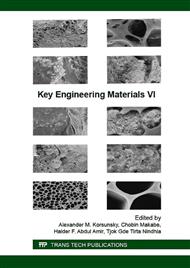p.155
p.163
p.168
p.174
p.179
p.186
p.190
p.199
p.204
Calculation of the Rate of Helium Ion Dispersion in Gallium Arsenide Compound
Abstract:
Nuclear dispersion is an important aspect in the process of slowing down ions by transferring their momentum to the target atoms and in determining path of the ion. This paper concerns the quantitative evaluation of the mechanism at which helium ions lose their energy when penetrate into a solid and the eventual distribution of the helium ion while stopping inside the Gallium Arsenide compound (GaAs). The first order effects of the atoms of the compound such as the electronic excitation of the atom, the lattice damage incurred to it, as well as the production of phonons in Gallium Arsenide due to the helium ions are also taken into account. The main finding is the mechanism of penetration of helium ions in GaAs, which is affected by the energy, the angle of incidence, and penetration density of the helium ions. It is found out that the energy has major impact than the angle of incidence in the interaction.
Info:
Periodical:
Pages:
179-185
Citation:
Online since:
August 2016
Authors:
Keywords:
Price:
Сopyright:
© 2016 Trans Tech Publications Ltd. All Rights Reserved
Share:
Citation:


